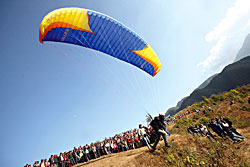 KIRAN PANDAY TAKING FLIGHT: Entrepreneurs are attempting to diversify tourism products by opening up paragliding as an adventure sport for the first time in Kathmandu valley. |
Their woes are global and local. The recession has hit Nepal's main sources of tourists from Europe, the United States and Australia. But fears of instability, the power cuts, shortages and labour problems have dented Nepal's image as well.
Osho World Travel in Thamel reaped revenues of Rs 100 million last year, but says sales have halved. Trip cancellations are coming in at hotels across the capital and in Pokhara.
"The tourism industry is facing high volatility, Nepal will start feeling the pinch in the next six months," says Mahesh Baskota, professor at Kathmandu University, "when developed countries catch a cold, Nepal gets pneumonia."
Nevertheless, the Ministry of Tourism and Civil Aviation has decided to go ahead with its Visit Nepal Year 2011, a campaign that aims to raise tourist arrivals to one million annually. But for that the current seat crunch will have to be addressed by adding flights, Kathmandu airport needs to be upgraded and the lack of investment in tourism infrastructure during the war years needs to be remedied.
"We are trying to establish an air service act to create more intimate connections between India and Nepal," Tourism Minister Hisila Yami tell s Nepali Times. She says Kathmandu's overcrowding has eroded its architectural charm. "The challenge will be to rejuvenate it and make tourists stay longer."
The ministry also hopes to add planes to Nepal Airlines, decongest Kathmandu, fly international traffic directly into Bhairawa and Pokhara, and make sure Nepal can deal with the numbers.
In 2008, Nepal received 800,000 visitors, up 30 per cent from the previous year. The last 1998 Visit Nepal Year campaign had an inflow of 500,000 tourists.
"I think the private sector is quite excited because we have tried to cut through the red tape and get things done," Yami says, "if there is capacity and viable routes, I want to let airlines add flights."
But industry players are skeptical. They have heard it all before from successive government since 1990. They say preserving Kathmandu's urban environment from decay has been on the cards for decades and needs a multi-sectoral approach. It can't just be a wish.
Meru Harsha of Shanker Tours says the government must first provide basic amenties like power, petrol and water to Nepalis before getting ambitious about one million tourists by 2011.
 KIRAN PANDAY |
Providing better transportation from airports and tougher crackdowns on touts are imperative as they create poor first and last impressions on tourists, operators say.
Uncertainties about the peace process are also casting a pall over the spring tourist season. The bottom line for most in the tourism industry is that there should be political stability, fewer hiatuses and shutdowns. The three-day hotel strike in Pokhara did untold damage to Nepal's image, they say.
"If tourists were to choose among India, Nepal and China to visit they wouldn't choose us because there is so much uncertainty and unanswered questions," says Baskota, "we just haven't learnt from our mistakes."
Nevertheless there is still something to look forward to in the coming months, where tourism arrival rates are expected to peak. Greenwich Village Hotel in Sanepa, which saw 90 per cent occupancy rates last Spring is expecting similar or better returns this year.
"Business slowed down dramatically during 2002 to 2006 but has been picking up since 2007,"says Operation Manager Bhuban Bahadur Baral.
Director of Airway Travel and Tours, Mahesh Adhikaii also expresses optimism: "Currently, we're having an average of 50 to 60 airline bookings per month but hopefully the numbers will reach 150 to 200 during the peak season. This would be a critical period for tour agencies to boost earnings."


